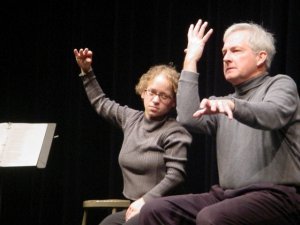Signing Workshop,
Assembly Help
Students Connect
with Silence, Senses
By Margaret Lipman (March 19,
2004)
In a prelude to the afternoon theatrical
production of Celebration of the Senses, Tim McCarty, president of Quest:
Arts for Everyone and director of Celebration, worked with a group of high
school students to explore the different ways of interpreting language
and poetry. The theme of McCarty’s workshop was how to apply theatre, mime,
and sign language techniques to literature. The GMHS students attended
the workshop based on their interest in creative and performing arts. Surprisingly,
many of the attendees did not have prior knowledge of American Sign Language
(ASL), but were eager to learn about the use of silent dramatic expression
for description and narration.
 |
McCarty has had much
experience in the area of unconventional literary interpretation. He has
worked at Gallaudet University's Model Secondary School for the Deaf for
21 years and served for the last eight as the artistic director of the
school’s Performing Arts program. He founded Quest: Arts for Everyone in
1997 to showcase the talents of the disabled artists and performers, who
are still drastically underrepresented in most areas of drama and art.
All of Quest’s productions have a diverse cast and include both deaf and
hearing actors of all ethnicities.
Tim McCarty was joined in Tuesday
morning’s workshop by Kris daCosta, an ASL instructor here at George Mason.
ASL was used frequently in the session, but was verbally translated for
and by the students. The workshop began with ‘warm-ups’ to accustom the
students to facial expressions and body language. Their concentration and
attentiveness were tested by a game of mimicking each other’s subtle facial
expressions. Next, they had to harness their emotions to show bold gestures
of love, hate, and disgust. |
Shira
Grabelsky and Mike Harper, professional
actors from Quest,
used speech, sign, and movement
to help students
experience poetry in a new way in
an assembly Tuesday
in honor of Deaf History
Heritage Month.
(Photo by Kory Lloyd) |
| From there,
the students broke into several groups and began analyzing the poems "Language
for the Eye" and "13 Ways of Looking at a Blackbird," written by Dorothy
Miles and Wallace Stevens, respectively. Even though many students had
little or no ASL experience, they were able to use universal gestures and
movement to represent both the abstract and concrete images of the poems.
McCarty called this fun, challenging approach the "process of true knowing."
He guided the students to a more exact understanding of the poems’ themes
and imagery, a process that he said is helpful when scrutinizing any book.
Although the workshop lasted for
just under two hours, many students came away with a deeper knowledge of
communication. "It was an interesting experience, but I think it would
be easier to understand if you had taken sign language," commented ASL
student Sarah Jacobs. McCarty seemed pleased with the result of the workshop,
as well. When questioned about his passion for this unusual method of teaching,
McCarty replied, "It’s what I love to do, to share it with as many people
as possible, enhancing reading and poetry by going beyond the words." |
 |
Jessica
Cartwright, center, and Matt Langford,
right, work together
to express a difficult passage
from Wallace Stevens’s
poem “13 Ways to Look at
a Blackbird” as
Tim McCarty, president of Quest,
during a workshop
McCarty conducted to help
students apply
theater, mime, and sign language
techniques to literature.
(Photo by Margaret Lipman) |
Needless to say, the students in
attendance certainly learned a lot about alternative methods of expression,
and undoubtedly gained a new respect for the deaf and disabled artists
who use silent expression as their primary mode of communication. By the
conclusion of the workshop, all were eagerly awaiting the performance of
Celebration of the Sense, and were curious to see just how much the morning’s
supplementary ASL experience would help them to better understand literature,
drama, and the world around them.
Tell us what you think.
E-mail lassogmhs@hotmail.com
|

